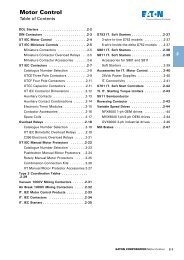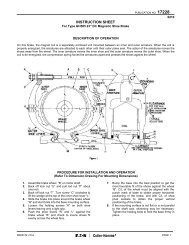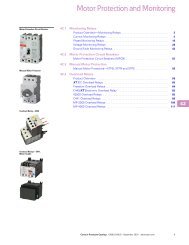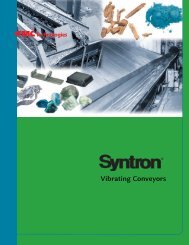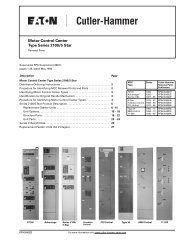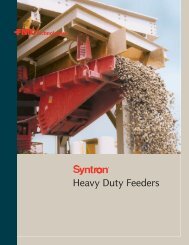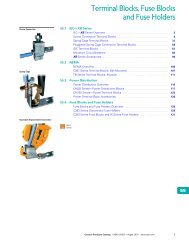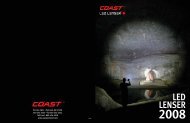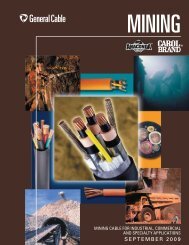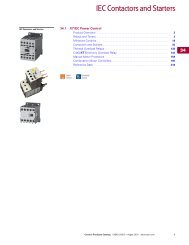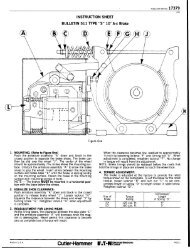Syntron® Vibrators - FMC Technologies
Syntron® Vibrators - FMC Technologies
Syntron® Vibrators - FMC Technologies
Create successful ePaper yourself
Turn your PDF publications into a flip-book with our unique Google optimized e-Paper software.
Electric Rotary <strong>Vibrators</strong><br />
Mounting Syntron ® Electric Rotary <strong>Vibrators</strong><br />
Vibrator selection and installation is based upon<br />
individual application requirements. For vibration<br />
distribution, each electric rotary bin vibrator should<br />
be mounted midway, on a length of channel, welded<br />
with its legs against the side of the bin. All electric<br />
rotary bin vibrator models can be mounted with the<br />
shaft in any position from horizontal to near vertical.<br />
For maximum effectiveness, chutes requiring vibrators<br />
should be independently isolated. In addition, the<br />
vibrator should be mounted midway on a channel<br />
located underneath the length of the chute.<br />
Note: For free-flowing bulk material installations,<br />
vibrators on hoppers should operate only when the<br />
hopper is open to flow. Otherwise, packing of material<br />
can result.<br />
Conical Hoppers<br />
Mount vibrator by channel-iron<br />
stiffener 3 to 7 feet long (1-2 m)<br />
to hopper wall, one-fourth to<br />
one-third the distance from the<br />
discharge to the top. A second<br />
vibrator (if necessary) should be<br />
mounted diametrically opposite<br />
and approximately halfway up<br />
the bin wall.<br />
Rectangular Hoppers<br />
Mount as for conical hoppers<br />
on the centerline of one side.<br />
A second vibrator may be<br />
required if complete cleaning<br />
of all corners and sides is<br />
desired. To mount, follow<br />
instructions for conical hoppers.<br />
Rectangular Bins with Hopper<br />
Bottoms<br />
Usually requires larger force<br />
vibrators than conical or rectangular<br />
hoppers because of additional<br />
head load. Locate vibrator<br />
one-fourth to one-third the distance<br />
up sloping section of bin<br />
wall, and follow mounting<br />
instructions for conical hoppers.<br />
Parabolic Bins or Hoppers<br />
Mount vibrator within one foot<br />
of each discharge opening and<br />
in line with center of opening.<br />
Chutes<br />
To move the material in a<br />
chute, the chute should be<br />
inclined to no less than half<br />
the "angle of repose" of the<br />
material (at least 10 degrees).<br />
On chutes from six to 10<br />
feet (1.8 - 3 m) long, two<br />
vibrators are needed; one<br />
should be placed 18 - 24 inches (457 - 610 mm) from the<br />
discharge and the other approximately in the middle.<br />
Since chutes are very sensitive to vibration, a provision<br />
should be made to move the lower vibrator six inches<br />
(152 mm) in either direction. This could mean the difference<br />
between moving the material or not moving it.<br />
Vibrator shaft (eccentric weight) should be rotating in the<br />
direction of material flow.<br />
Bins with Sloping Discharge<br />
Mount the vibrator one-sixteenth to oneeighth<br />
the distance up bin wall that is<br />
contiguous with the underside of chute.<br />
This lower mounting position puts vibrator<br />
close to bin discharge throat and assures<br />
vibration transference into chute.<br />
Bin or Hopper with Vertical Side<br />
Mount vibrator on wall with the<br />
least slope. Follow mounting instructions<br />
for rectangular bins with hopper<br />
bottoms.<br />
Note: Drawings illustrate typical installations. Specific installations may<br />
require slight variations. For other applications not covered here, please consult<br />
factory for recommendations.<br />
30



